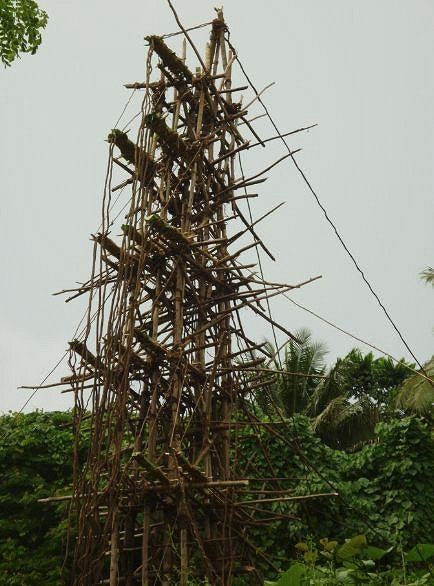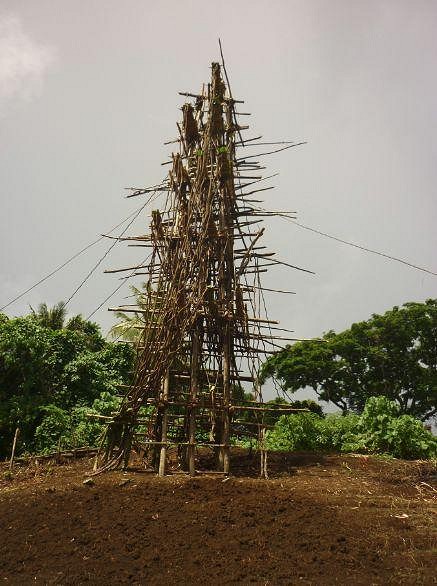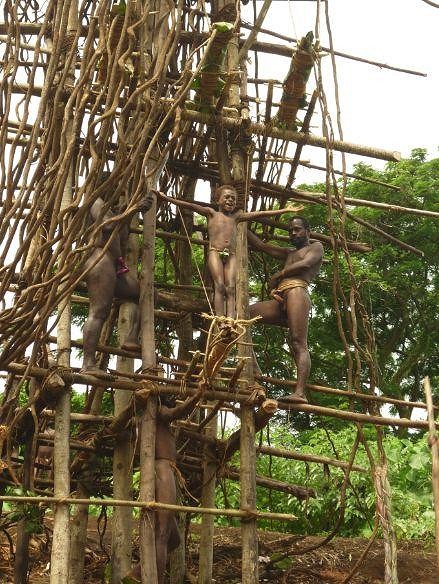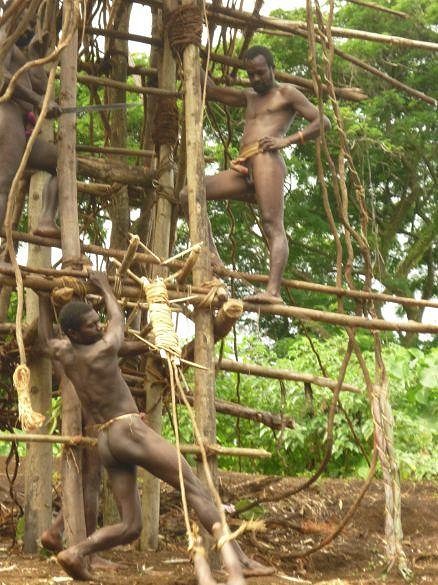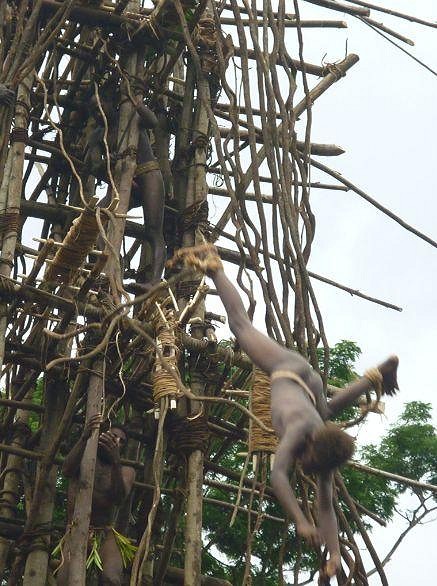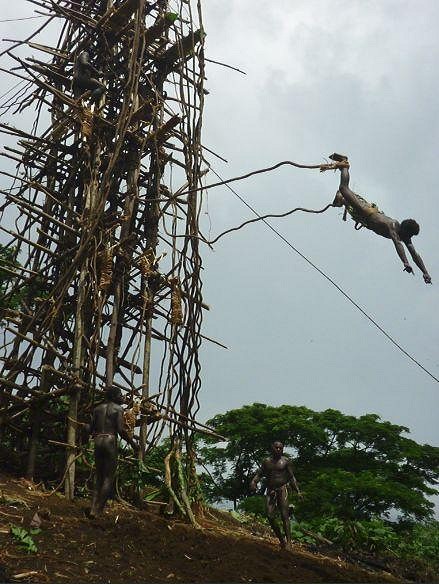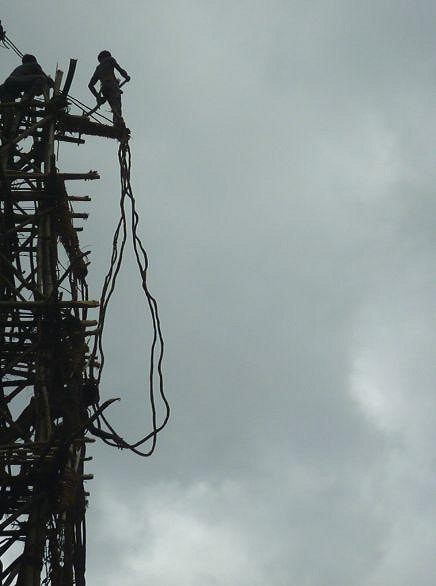Tiki Central / Tiki Travel / Club Nouméa's Tiki Tour of Vanuatu
Post #599139 by Club Nouméa on Mon, Jul 25, 2011 3:44 AM
|
CN
Club Nouméa
Posted
posted
on
Mon, Jul 25, 2011 3:44 AM
Part 6 - Land Diving on Pentecost
About a thousand years ago, a sexually dissatisfied husband on the island of Pentecost called Tamalie used to beat his wife to the extent that she decided to run away. Although she climbed a huge banyan tree to hide from him, he nonetheless found her. As he climbed up the tree to get her, she kept climbing higher, until there was nowhere to go but along a branch, where she tied liana vines to her ankle. As Tamalie reached out to grab her, she jumped. Thinking she had killed herself, he threw himself off the tree in despair at his maltreatment of her, and plummeted to his death. Unfortunately for Tamalie however, the vines were just long enough to have broken her fall, and although she hit the ground, she lived. In response to this unprecedented event, shocked local men began taking the precaution of practicing "naghol" (land diving) themselves, whilst banning women from doing it. Nowadays, the ritual is multi-layered, being a combination of a coming-of-age manhood ritual, an expression of freedom and a defiance of the laws of nature, a masculine feat that is a mix of an act of atonement and a "won't get fooled again" statement, and even an opportunity for the men who perform it to discuss their marital difficulties during a pre-jump speech, addressing their women standing below the tower.
The land-diving tower itself is several storeys high. The one in the photo was the height of a four-storey building. The centre of the tower is a living tree that is stripped of its branches and foliage and has scaffolding built up around it. The tower is cross-braced with liana vines attached to trees nearby to stabilise it and increase its loading capacity. The area beneath the tower is completely cleared of vegetation and is dug up to a depth of about 10 inches, with any stones or rocks being removed. This provides the "landing pad" for the divers. Unlike bungy jumpers, land divers hit the ground, landing chest first on the soil, with the length of the vine providing the braking force required to minimise the speed of impact immediately before hitting the ground. With the assistance of a tribal elder, each jumper carefully selects his own liana vines, and they have to be accurately measured and securely fastened to the "sighol" (diving platform) in order to ensure that their user does not plummet to his death.
While the ritual is performed, a chorus of men, boys and women chant and sing, providing encouragement and moral support. The first jumper I saw looked about 4 years old, and jumped from a height of 6 feet:
Those who choose to dive are trained from a very early age. Small boys like this one practice by jumping from their fathers' shoulders. The lad looked very keen, and had a successful landing:
When the jumper leaps and reaches the end of the vine, his falling weight causes the sighol to break, which also helps to reduce his acceleration just before hitting the ground chest first. You can just see the boy's legs at the moment of landing here, but this was an exceptional shot. I decided from the outset to take no photos of the divers hitting the ground. It seemed insulting to photograph them face down in the mud, at their weakest moment, when what they were doing was about the freedom of flying through the air. The next level was about 12 feet off the ground, and three boys, aged about 7 or 8, attempted jumps.
The first boy jumped successfully, but the next one was nervous, and backed out. He was helped off his platform, and it was ceremoniously broken to make sure that no one else used it. There was no jeering, no cries of "what are ya?", and no macho bullshit from the elders or other members of the tribe. Jumping is a personal decision, made by a select few. If you are tense or nervous, you will misjudge your dive and will kill yourself. Unlike bungy jumping, where you simply step off into the void and allow a giant elastic band to act as your safety line, a naghol jump requires careful balancing, and the same graceful launch as an Olympic high diver, except that there is no water to cushion your impact. Quite simply, if you hit the ground at the wrong angle during the naghol, you will break your neck.
The next group of jumpers were late adolescents and jumped from a height of about 18 feet.
One of their number had a bad landing. One of the support vines holding the tower up snapped at the time of his jump, and the tower must have shifted as a result, changing the jumping height slightly, because he had a hard landing. There was hushed silence for about 45 seconds before he painfully stood up with a very big grin on his face, thankful to be alive. The tower was very quickly resecured. In spite of the danger involved in jumping, the elders who oversee the naghol take every safety precaution, and know exactly what they are doing. There has only been one naghol death in recent times. In 1974, Queen Elizabeth II visited Pentecost out of season, when the liana vines were too brittle to safely make a jump. Various bigwigs nonetheless insisted that the feat should be staged for the Queen, and the result was that a man plummeted to his death. There was hushed silence as the final jumper readied himself to jump from the top level. Four storeys may not sound like much, but when you are standing at the bottom, it looks like a LONG way up Before:
After:
The land-diving ceremony had been immediately preceded that afternoon by a cloudburst, followed by clear skies that lasted until just a few moments after the final jumper walked away from the tower uninjured. Then it started pouring down. CN |

